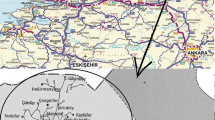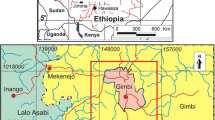Abstract
By analyzing the topographic features of past landslides since 1980s and the main land-cover types (including change information) in landslide-prone area, modeled spatial distribution of landslide hazard in upper Minjiang River Basin was studied based on spatial analysis of GIS in this paper. Results of GIS analysis showed that landslide occurrence in this region closely related to topographic feature. Most areas with high hazard probability were deep-sheared gorge. Most of them in investigation occurred assembly in areas with elevation lower than 3 000 m, due to fragile topographic conditions and intensive human disturbances. Land-cover type, including its change information, was likely an important environmental factor to trigger landslide. Destroy of vegetation driven by increase of population and its demands augmented the probability of landslide in steep slope.
Similar content being viewed by others
References
Li Ainong, Wang Angsheng, Liang Shunlin,et al. Eco-Environmental Vulnerability Evaluation in Mountainous Region Using Remote Sensing and GIS—A Case Study in the Upper Reaches of Minjiang River, China [J].Ecological Modelling, 2006,192:175–187.
Qiao Jianping. Study on the Regularities Governing the Density Distribution of Collapses and Landslides on the Upper Minjiang River Basin [J].Resources and Environment in the Yangtze Valley, 1994,3(4):365–370 (Ch).
Mario Parise. Landslide Mapping Techniques and Their Use in the Assessment of the Landslide Hazard [J].Phys Chem Earth, 2001,26:697–703.
Dai F C, Lee C F, Ngai Y Y. Landslide Risk Assessment and Management: An Overview [J].Eng Geo, 2002,64:65–87.
Ayalew L, Yamagishi H. The Application of GIS-Based Logistic Regression for Landslide Susceptibility Mapping in the Kakuda-Yahiko Mountains, Central Japan [J].Geomophology, 2005,65:15–31.
Zhang Yiping, Zhang Zhaohui, He Yunling. Distribution of Climatic Elements in the Upper Reaches of Minjiang River [J].Journal of Mountain Science, 2004,22(2):179–183 (Ch).
Hu Zhibin, He Xingyuan, Jiang Xiaobo,et al. Landscape Pattern Change at the Upper Reaches of Minjiang River and Its Driving Force [J].Chinese Journal of Applied Ecology, 2004,15(10):1797–1803 (Ch).
Wang Yunsheng, Li Yusheng. Analysis on the Controlling Factor of Formation of Landslides and Avalanches in Manaoding-Lianghekou, Upper Reaches of Minjiang [J].Journal of Chengdu University of Technology, 2000,27(Suppl):205–208 (Ch).
Meng Hui, Zhang Yueqiao, Yang Nong. Analysis of the Spatial Distritution of Geohazards along the Middle Segment of the Eastern Margin of the Qinghai-Tibet Plateau [J].Geology in China, 2004,31(2):218–224 (Ch).
Zhou C H. On the Spatial Relationship between Landslides and Causative Factors on Lantau Island, Hong Kong [J].Geomophology, 2002,43:197–207.
Zhang Yuandong, Zhao Changming, Liu Shirong. The Influence Factors of Sub-Alpine Forest Restoration in Miyaluo, West Sichuan [J].Science Silvae Sinicae, 2005,41(4):189–193 (Ch).
Yan Echuan, Liu Hanchao, Zhang Zhuoyuan A Study on the Distribution Regularity of Landslide in the Minjiang River between Maowen and Wenchuan County [J].Mountain Research, 1998,16(2):109–113 (Ch).
Author information
Authors and Affiliations
Corresponding authors
Additional information
Foundation item: Supported by the Knowledge Innovation Program of Chinese Academy of Sciences (KZCX2-SW-319 01) and Department of Science & Technology of Sichuan Province ([2005]-172-140107).
Biography: FENG Wenlan (1979-), female, Ph. D. candidate, research direction: application and development of geographic information system and remote sensing.
Rights and permissions
About this article
Cite this article
Wenlan, F., Qigang, Z., Baolei, Z. et al. GIS-based spatial analysis and modeling for landslide hazard assessment: A case study in upper Minjiang River basin. Wuhan Univ. J. Nat. Sci. 11, 847–852 (2006). https://doi.org/10.1007/BF02830175
Received:
Issue Date:
DOI: https://doi.org/10.1007/BF02830175




